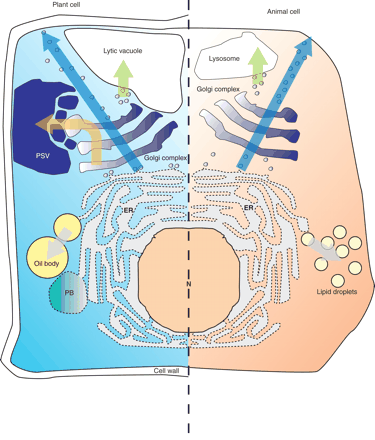
- Institution: Stanford Univ Med Ctr Lane Med Lib/Periodical Dept/Rm L109
- Sign In as Member / Individual
Recombinant Pharmaceuticals from Plants: The Plant Endomembrane System as Bioreactor

The secretory pathways of plant cells versus animal cells: Opportunities to exploit plants as bioreactors. Secretory proteins enter the ER (delimited here by the broken line, indicating membrane-bound ribosomes) in both cell types and travel to the Golgi complex via vesicular trafficking. In the absence of ER-retention signals, soluble proteins are then secreted (blue arrows). Vesicular sorting to the inner hydrolytic compartments (lytic vacuoles in plants, lysosomes in animals; green arrows) requires signals that differ in plants and animals. In addition to lytic vacuoles, plant cells may also have protein storage vacuoles (PSV), which develop according to specific signals and protein sorting mechanisms (orange arrow) and may be useful in the biotechnological production of recombinant pharmaceutical proteins. Vast amounts of proteins of cereals (e.g., the prolamin storage proteins) form protein bodies (PB) within the ER in aggregation processes that may also be exploited for biotechnology; the aggregation mechanisms are an area of active research and may involve prolonged interactions with chaperones, the formation of inter-chain disulfide bonds, and selective insolubility (28). Oil bodies and lipid droplets originate from the ER by the deposition of lipids in the space between the two monolayers of the ER membrane (gray arrows).


